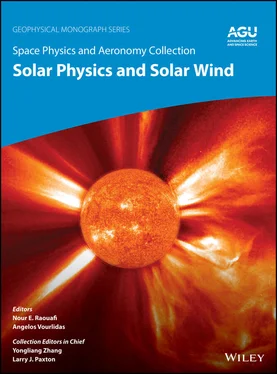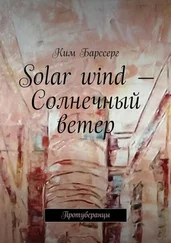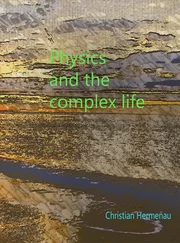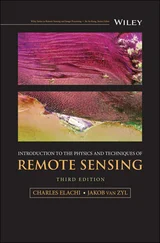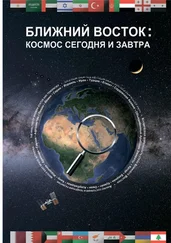1 ...7 8 9 11 12 13 ...27 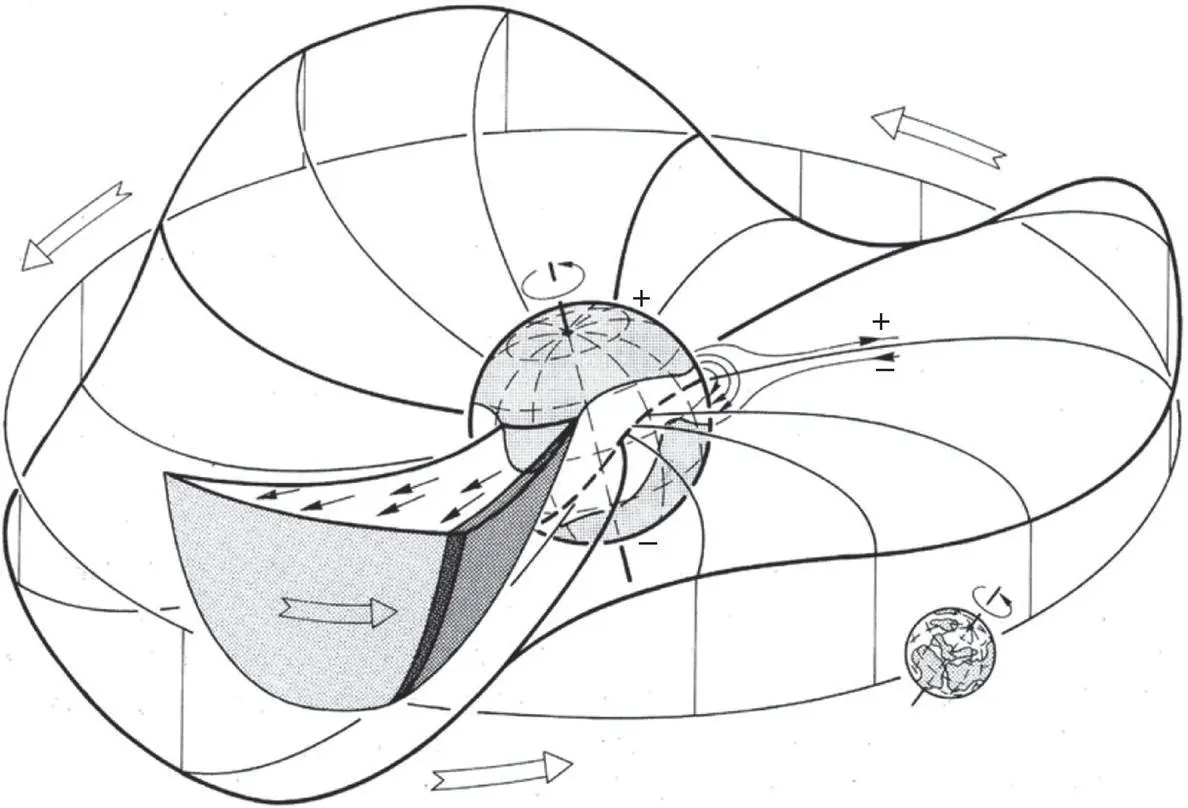
Figure 1.6 Configuration in the inner heliosphere of a “ballerina skirt” heliospheric current sheet extending above the streamer belt near solar minimum (for A > 0 solar magnetic field polarity, that is, outward field at the north pole), which lies ahead of a high‐speed stream (drawn truncated at high latitudes) from an equatorward extension of a northern polar coronal hole. The dark shaded region is the interaction region.
( Source : Image reproduced with permission from Schwenn, 1990, © 1990, Springer.)
1.3.2. Composition of the Solar Winds
Figure 1.7presents solar wind parameters during the passage of a high‐speed stream bound by two intervals of the slow wind. In situ measurements at 1 AU and beyond are not ideal to study the origin of the solar winds because the latter evolve greatly between the Sun and 1 AU. For example, the fast and slow winds interact during transit to 1 AU, and the distribution functions are strongly affected by a number of processes during transport from the Sun as discussed later in this chapter. In essence, the solar wind undergoes a number of processes that irreversibly erase information on their source regions during transit. Wind properties that remain unchanged during transit to 1AU are the abundance and ionization state of minor ions. They provide crucial information on the origins of these winds.
As an element rises in the solar atmosphere from the chromosphere to the hot corona, its ionization level increases due to radiative and collisional processes. This carries on until it reaches a height where radiative ionization is too weak and collisions are rare. Beyond that height, the charge state is said to be “frozen” and remains unchanged until it is measured in situ in the interplanetary medium. A measure of the charge state of heavy ions therefore provides unique information on the temperature at the source regions of the solar winds (Geiss et al., 1995). The charge state of an ion species will increase with temperature at the collisional coronal base of a solar wind flux tube. Solar wind measurements have shown that the carbon and oxygen ions have lower charge states (07+/06+ or C5+/C6+) in the fast than in the slow wind (Geiss et al., 1995; Kasper et al., 2012). This is clearly seen in Figure 1.7for the 07+/06+ ratio.
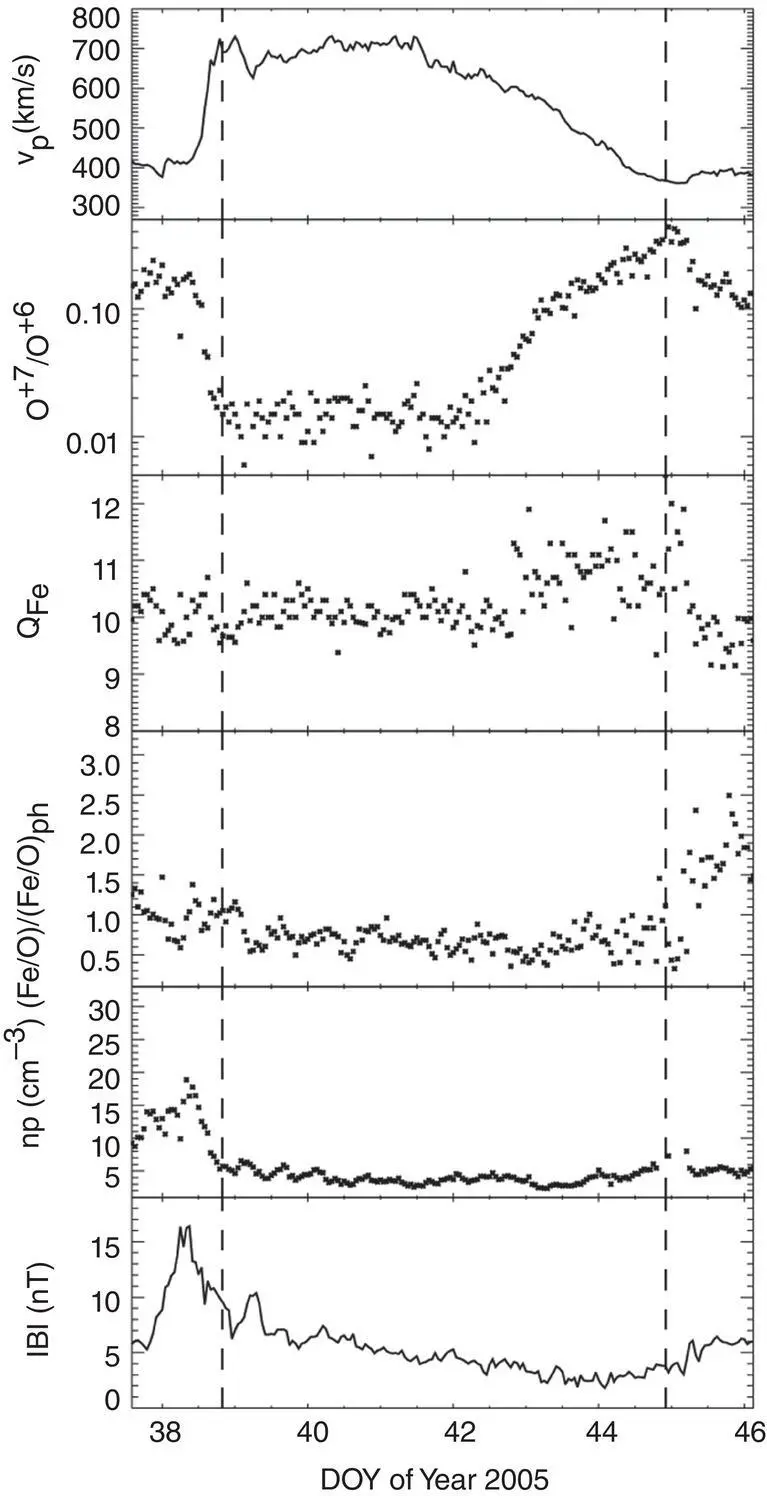
Figure 1.7 Typical time profiles of solar wind parameters for a selected solar wind interval. The SW parameters are (from top down) proton speed (vp), O+7/O+6 density ratio, average charge of Fe (QFe), Fe/O relative to its photospheric value (0.0646; Asplund et al., 2009, related to the first ionization potential, FIP, bias), proton density (np), and the magnitude of the associated interplanetary magnetic field (—B—). The selected SW interval is between the two vertical dashed lines.
( Source : Image taken with permission from Ko et al., 2014. © 2014, IOP Publishing.)
Electron temperatures prevailing in the source region of the fast solar wind are therefore lower than temperatures near the source region of the slow wind (temperature smaller than 1.2 MK). Near 1 AU, where ion temperatures of the fast and slow solar winds are higher than temperatures estimated from charge state ratios. This suggests that sustained heating processes occur in the fast and slow solar wind in the corona well above the heights where ionization states are frozen (Lopez et al., 1986).
Sharp O7+/O6+ boundaries occur at both leading and trailing edges of high‐speed streams, suggesting rapid transitions between different coronal sources (Borovsky & Denton, 2016; Burton et al., 1999). High‐cadence measurements of the ionization state of heavy ions in the slow wind have recently revealed a high degree of variability, changing by an order of magnitude inside density structures (Kepko et al., 2016). This will be discussed later in the chapter.
The higher charge state of heavy ions measured in the slow wind necessarily results from higher temperatures and densities at the coronal base of open field lines channeling the slow wind. Numerical models of the solar coronal plasma and magnetic field have been used to study the origin(s) of the slow wind. They reveal that magnetic fields are generally stronger at the base of flux tubes channeling the slow wind (Wang et al., 2009). There is a clear statistical correlation between coronal regions threaded by strong magnetic fields in the form of loops or open magnetic fields and high‐plasma temperatures (Schrijver et al., 2004). Therefore, one possible interpretation for the high charge‐state ratios measured in the slow wind resides in strong local heating near its source region due to the strong magnetic fields (Wang et al., 2009). Such a strong heating at the coronal base would lead to a strong heat flux conducted down to the chromosphere and enhanced densities in the slow wind. In contrast, less evaporation is likely to occur near the cooler source region of the fast wind, leading to a more tenuous fast wind. This interpretation can explain the fairly constant mass flux measured in situ in the fast and slow solar winds.

Figure 1.8 Element abundances as a function of the first ionization potential (FIP) in the average slow solar wind, fast solar wind. Abundances are given relative to oxygen and are normalized to photospheric abundances.
( Source : This figure was taken from Geiss, 1998 with permission from SSR. © 1998, Springer Nature.)
An alternative theory for the origin of the high charge states measured in the slow wind suggests that plasma initially confined to coronal loops is released along open magnetic field lines (Fisk et al., 1998; Schwadron et al., 1999). Loop plasma would naturally be pushed to higher ionization states because loops host typically hotter and denser plasma than open fields of coronal holes (Schwadron et al., 1999). For this mechanism to work, loop plasma must find a way to be transferred to the open field, which would require magnetic reconnection to occur continually.
The fast and slow solar winds also differ in their abundance of elements with low First Ionisation Potential (FIP), that is, the minimal energy required to ionize an atom. This first ionization occurs in the chromosphere for most elements. Overall, the corona and the solar winds exhibit higher abundances of elements with low FIP than known photospheric abundances. The slow wind exhibits even greater abundances of low‐FIP elements such as Si, Fe, and Mg than the fast solar wind (von Steiger et al., 2000; Zurbuchen et al., 1999) as seen in the fourth panel of Figure 1.7and in Figure 1.8. Such high abundances of low‐FIP elements are not measured remotely in coronal holes but are more typical of closed coronal loops (Widing & Feldman, 2001). This supports the idea that the slow wind is supplied by plasma initially trapped on coronal loops and that are subsequently released in the wind (Fisk et al., 1998). In contrast, the fast wind carries fewer elements with low FIP (von Steiger et al., 2000). The composition of the fast solar wind agrees roughly with that measured in coronal holes.

Figure 1.9 Left: The abundance of helium (computed as 100 times the density ratio of hydrogen) during 17 years of solar wind measurements by the Advanced Composition Explorer (ACE). The color coding indicates the solar wind speed. The monthly smoothed sunspot number is plotted as a black curve. Right: The abundance of helium relative to oxygen, measured by ACE/SWICS. The same trend of depletion with wind speed as for He/H is seen, but the solar cycle dependence is less pronounced.
Читать дальше
